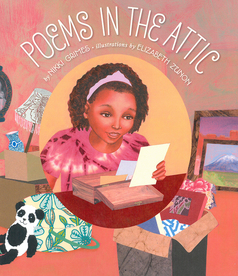Poems in the Attic: Nikki Grimes Illustrated Elizabeth Zunon

BIBLIOGRAPHY: Grimes, N., & Zunon, E. (2015). Poems in the attic. New York: Lee & Low Books. ISBN:978-1-62014-027-7
SUMMARY: A young girl learns much about her mother as she reads a collection of poems written before she was born that capture her mother’s memories of living around the world and growing up as a child of an Air Force serviceperson. Reading the poems and sharing those experiences through her mother’s eyes, the young girl feels closer to her mother than ever before. To let her mother know this, she creates a gift: a book with her own poems and copies of her mother’s poem. When she returns her mother’s poems to the box in the attic, she leaves her own poems too, for someone else to find, someday.
ANALYSIS: During a visit to her grandmother's house, a seven-year-old African-American girl discovers poems her mother wrote in her youth, giving the daughter a window into her mother's peripatetic upbringing as an Air Force brat. Grimes alternates between the daughter's free-verse poems and her mother's five-line tanka poetry. In one scene, the girl's grandmother shows her how to make paper luminarias, just as she did with her daughter while they were living in New Mexico "After we were done, our brown bag candle holders bloomed bright, lighting up the night"; a Japanese dinner between girl and grandmother ties into a trip to Japan. (In author's notes, Grimes highlights the poetic forms she uses, as well as the Air Force bases that correspond to locations in the book). Fully in step with Grimes's empathic writing, Zunon's warmly painted collages carry readers from the waterways of Virginia to a German castle atop a hill, highlighting the powerful emotional ties between the girl and her elders, as well as her mother's adventurous spirit. Using free verse for the young girl’s poems and tanka for her mother’s, master poet Nikki Grimes creates a tender intergenerational story that speaks to every child s need to hold onto special memories of home, no matter where that place might be."
USE: One of the poems from the book that show a highlight on the analysis is Aurora Borealis Alaska. “My brother and me held hands, breathless, as we watched this dancing rainbow shimmy ‘cross Alaska’s sky in a skirt of night and light”. (8) Grimes uses the strong figurative language to bring the poem to live. This particular poem isn’t boring , but the word choice gives the reader a picture and sound of what the mother and her brother experienced. The words danced across the page as I captured a image of what they captured.
Before sharing the book, I would have an inorganic discussion about bringing poetry to live and steering the kids away from boring words. After that, I would then allow them to try replacing some boring words in sample poems that would give the poetry a sound to draw the reader’s attention. Then, introduce the book and particularly the poems with strong figurative language and word use.

Comments
Post a Comment